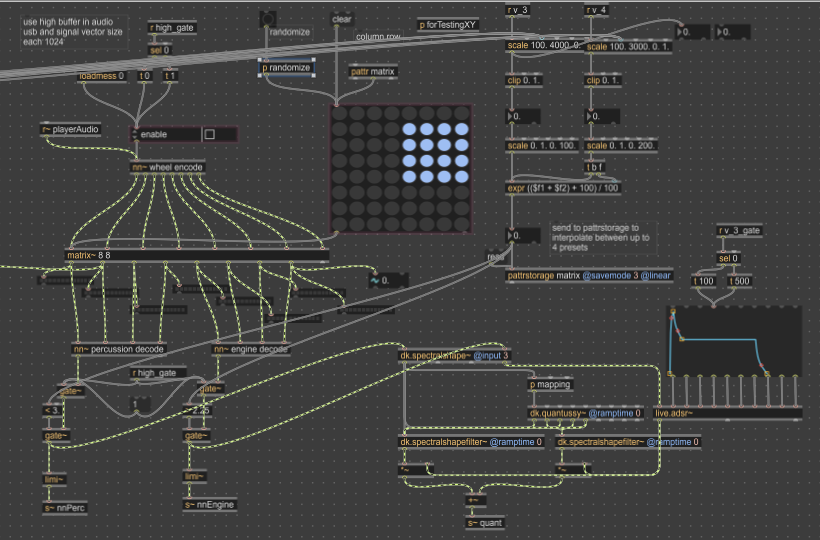Velocity Bounce, 2nd Draft

Velocity Bounce is an acousmatic work with video (view rough draft) - a musically reactive particle simulation if you want to be prosaic. However, I have chosen a combination of behaviors that include flocking and pulsating so that the particles tend to form symbiotic relationships, and sometimes act as single organisms. Therefore, I hope the effect will be more that of musical "creatures" or "beings", even if they are at times amorphic.
Here is a brief listing of the musical elements.
- Fundamental Partch oscillator, tuned to Partch's 43-note scale. The steps are determined by randomized curves, which are then quantized into steps. This feeds the pitches to the Somax II influencer
- Somax II player, producing sounds of either tuba of piccolo based on the Somax II influencer's (thus the Partch oscillator's) pitch
- Somax II player feedback
- Plucked bass (KS synth), driven by a sequencer that records rhythms (onsets) from the Somax II player in 20-second intervals, and takes its pitches from the phase modulating synthesizer's counterpoint generation
- Bass through a comb filter
- Phase Modulating synthesizer with counterpoint production. This takes the last 24 pitches from the Partch oscillator and randomizes them before playing
- Phase Modulating synthesizer feedback
- RAVE model of percussion, trained by Antoine Caillon
- RAVE model of noise, trained by James Bradbury
- Quantussy oscillators, here in a module by Rodrigo Constanza (dk.quantussy~ - still in beta testing). These are activated by the sounds from the RAVE models
What follows is a dry listing of relationships.
There are 4 species (between 2000 to 2400 particles), each one sends it velocity as a 1D vector from python into Max via OSC. Every two minutes, the patch queries whether species 1 or 2 has the highest absolute velocity. This creates the "pickle" parameter which determines:
- which "pickle" the Somax player chooses, tuba or piccolo
- the speed and octave of the Partch oscillator
- the settings of the interactive machine learning (Python/Anguilla) parameters (separate, align, cohere, radius)
- a gate for the bass sounds
- the octave for the counterpoint generator of the phase modulating synthesizer
The velocity of species 3 directly affects
- the attraction of the pulse parameters - thus affecting the states of all the species
- the amplitude envelope parameters of the quantussy oscillator
The velocities of species 3 and 4 create:
- a threshold over which the RAVE models* (percussion, engine) will become active
- a mapping for the latent spaces via pattstorage and a matrix object
The median of all 4 velocities provide
- a gate for the bass comb filter
- a gate, according to the direction of the medium (+ or -) for the phase modulating synthesizer
Some of the audio features in turn modify the behavior, thus the velocities, of the species, or other audio features.
A detected novelty from the Somax player (within either a tuba or a piccolo sound) will
- take the current mappings to two random species
- create a flurry of bass pizzicati
The frequency detected from the Somax player will directly affect the following. (The Somax does not always slavishly reproduce the pitches from the Partch oscillator.)
- the radius of the pulse behavior
- the amplitude envelope of the phase modulating synthesizer
